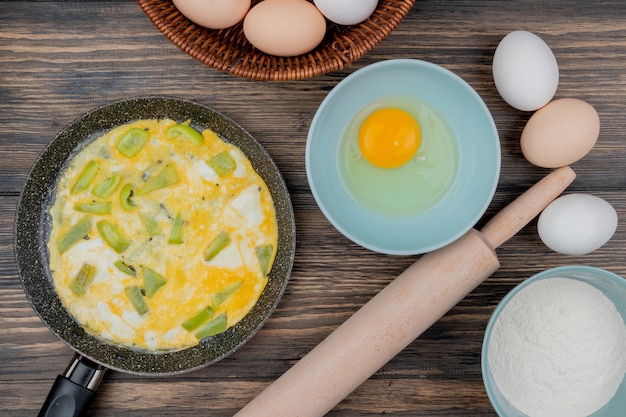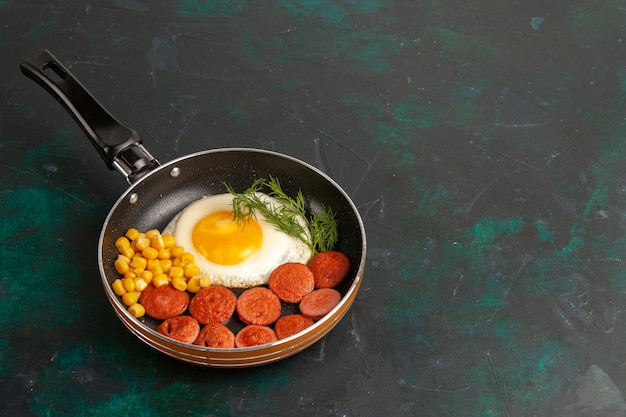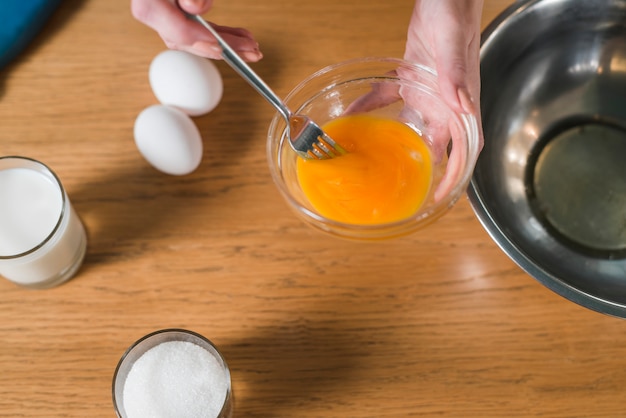Ah, eggs. Those little protein powerhouses that can be a quick breakfast, a satisfying snack, or a star ingredient in countless dishes. I've always loved eggs, but I'll admit, I haven't always been a master of cooking them. There was a time when my scrambled eggs resembled rubbery lumps, and my fried eggs were more like greasy blobs. It was a culinary nightmare! Thankfully, I've learned a lot over the years, and one of the biggest game-changers has been my trusty stainless steel pan.
Now, I know what you might be thinking: "Stainless steel? Isn't that a bit, well, basic?" It might not have the flashy allure of some other pan materials, but trust me, it's a real workhorse in the kitchen. And when it comes to cooking perfect eggs, it's an absolute game-changer.
So, why am I singing the praises of stainless steel? Let's dive in (Part 1):
Why Stainless Steel? A Culinary Love Affair

For years, I was convinced that nonstick was the only way to go for eggs. But I've been through my fair share of nonstick pans. The coating would start flaking off, or worse, get scratched and the food would stick like glue. It was a real pain, and I was tired of replacing pans every few months.
That's when I decided to give stainless steel a go. And I'm so glad I did. This humble material transformed my egg-cooking experience, and here's why:
Durability: Built to Last
stainless steel pans are built like tanks. They can handle high heat without warping or bending, and they're resistant to scratches and wear and tear. I've had my current stainless steel pan for years, and it's still going strong. It's seen countless scrambled eggs, omelettes, and poached eggs, and it's held up like a champ. No more worrying about flimsy pans that need constant replacement!
Even Heat Distribution: A Perfect Cook Every Time
This is crucial for eggs. Imagine this: you want your fried egg with a crisp, golden edge and a runny yolk, but instead, you get a burnt bottom and a raw centre. Not ideal, right? Stainless steel heats up quickly and evenly, ensuring a perfect cook from edge to edge, without any hot spots that could ruin your egg. No more unevenly cooked eggs for me!
Easy to Clean: A Breeze to Maintain
Let's be honest, nobody wants to spend ages scrubbing and soaking their pans after cooking. Stainless steel is a dream to clean. Just a quick wipe with a sponge and soapy water, and it's good as new. No more stubborn food residue, no more soaking, no more scrubbing. It's a real time-saver, especially when you're trying to whip up a quick breakfast.
Choosing the Right Stainless Steel Pan: A Guide to Finding Your Perfect Match

Okay, you're convinced about stainless steel, but how do you choose the right pan for your egg-cooking needs? Here's the lowdown:
Size Matters: Finding the Goldilocks Pan
For eggs, you don't need a massive pan. A small to medium-sized pan, around 8-10 inches in diameter, is perfect. You don't want a pan that's too big, or your eggs will spread out too thin and won't cook properly. You want that nice, concentrated heat to give your eggs a beautiful golden sear.
Thickness Counts: Building a Foundation for Even Cooking
You want a pan that's not too thin, or it will heat up unevenly. A thicker base will ensure even heat distribution and prevent hot spots. A pan with a 3-ply construction, where the base has multiple layers of metal for better heat transfer, is a good choice. Look for pans that feel substantial in your hand, you want that quality build.
The Material Matters: Understanding the Composition
Most stainless steel pans are made from 18/10 stainless steel, which means they have 18% chromium and 10% nickel. This combination gives the pan its durability and resistance to corrosion. Some pans may also have a copper core for even better heat distribution. Copper cores help the pan heat up faster and more evenly, which can be a real game-changer for getting those perfect golden edges on your fried eggs.
When choosing your pan, look out for features like encapsulated bases, which are a good indicator that the pan is well-made. These bases are designed to ensure even heat distribution and prevent warping.
Seasoning Your Stainless Steel Pan: Unlocking the Secret to Non-Stick Success

Now, here's a bit of a secret: seasoning your stainless steel pan is a must! It's like giving the pan a protective layer that helps prevent sticking and makes cooking easier. It's a simple process that transforms your pan into a non-stick superstar!
Why Season?
Even with a high-quality stainless steel pan, eggs might stick a little at first, especially if you're new to cooking with this material. But with seasoning, you create a non-stick surface that makes cooking smoother and easier. And once you've seasoned your pan, it'll get even better with every use. It's like a culinary friendship, the more you use it, the better it gets!
How to Season Your Pan: A Simple Guide to Non-Stick Perfection
Seasoning your pan is super easy, and it's a worthwhile investment for perfect eggs. Here's how to do it:
- Wash your new pan with soapy water. Give it a good clean to remove any factory residue.
- Dry it thoroughly, and place it on the stove over medium heat. Let it warm up for a few minutes.
- Once the pan is hot, add a thin layer of oil (I like to use vegetable oil). Don't go overboard, just a light coating.
- Swirl the oil around the pan so it coats the entire surface. You want to create an even layer of oil.
- Reduce the heat to low, and let the oil heat up for about 5 minutes. You should see a light wisp of smoke. This indicates that the oil is getting hot enough to polymerize, creating that non-stick layer.
- Remove the pan from the heat, let it cool completely, and then wipe out any excess oil. Be careful, the pan will be hot!
That's it! You've now seasoned your pan. You'll want to repeat this process every few uses, especially if you notice your eggs starting to stick a little. It's like giving your pan a little TLC, keeping it in top shape.
Tips for Cooking Perfect Eggs: Unlocking the Secrets of Egg Perfection
Now that you have your seasoned pan, it's time to get cooking! Here are some of my tips for cooking perfect eggs in your stainless steel pan. Get ready to elevate your egg game!
Fried Eggs: Achieving Sunny-Side-Up Perfection
For those perfect sunny-side-up eggs, with a runny yolk and a crispy golden edge, try this method:
- Heat your pan over medium heat. You want the pan to be hot, but not smoking. You can test the heat by sprinkling a few drops of water on the surface. If the water sizzles and evaporates quickly, your pan is ready.
- Add a small amount of oil or butter, just enough to coat the bottom of the pan. I prefer using a neutral oil like vegetable oil or canola oil.
- Crack your eggs directly into the pan. Don't worry about any tiny pieces of shell, you can easily remove them with a spoon. Cracking your eggs directly into the pan helps to prevent any unnecessary stirring or breakage.
- Reduce the heat to low and let the eggs cook for about 3-4 minutes, until the whites are set and the yolks are still runny. Be patient! Low heat is key to getting that perfect consistency.
- If you want a crispy edge, you can increase the heat for the last minute of cooking. Just watch it carefully, as it can burn quickly.
- Use a spatula to gently slide the eggs onto a plate. Be careful not to break the yolk, we want that beautiful runny center.
Scrambled Eggs: Achieving Fluffy, Creamy Deliciousness
Scrambled eggs can be a bit tricky, but with the right technique, they can be incredibly fluffy and creamy. Follow these steps for perfect scrambled eggs:
- Heat your pan over medium heat. You want the pan to be hot enough to cook the eggs quickly, but not so hot that they burn.
- Add a small amount of butter or oil to the pan. I like to use a combination of butter and oil for extra flavour.
- Crack your eggs into a bowl, and whisk them with a fork. You want to incorporate a bit of air into the eggs for a fluffy texture.
- Pour the egg mixture into the hot pan and cook, stirring constantly. Use a spatula or a wooden spoon to gently stir the eggs, making sure to scrape the bottom of the pan to prevent sticking.
- Don't overcook them, you want them to be soft and creamy. The key to fluffy scrambled eggs is to cook them over medium heat and stir constantly.
poached eggs: Mastering the Art of Poaching
Poached eggs can be a bit tricky, but with the right technique, they're surprisingly easy. Follow these steps for perfect poached eggs:
- Fill a saucepan with about 2 inches of water. You want enough water to cover the eggs by about an inch.
- Add a splash of vinegar to the water. The vinegar helps the egg white coagulate and hold its shape, preventing it from spreading out too much in the water.
- Bring the water to a gentle simmer, you want tiny bubbles to rise to the surface. Don't let the water boil, as this will cause the eggs to cook too quickly and become rubbery.
- Crack an egg into a small bowl or ramekin. This allows you to check for any shell fragments before placing the egg in the water.
- Gently swirl the water in the pan to create a whirlpool. This will help the egg white to form a nice, compact shape, preventing it from spreading out too much.
- Carefully slide the egg into the center of the whirlpool. Be gentle! You want the egg to fall gently into the water.
- Cook for 3-4 minutes, until the white is set and the yolk is still runny. The cooking time will vary depending on the size of the egg and your desired level of doneness.
- Use a slotted spoon to lift the egg out of the water and onto a plate. Carefully remove the egg from the pan and drain any excess water.
FAQs: Answering Your Egg-Cooking Questions
You know what they say, a good question can be the start of a great conversation. So, here are some common questions about stainless steel pans and eggs, and my answers to them:
Q1. How do I tell if my stainless steel pan is hot enough for eggs?
A. A good trick is to sprinkle a few drops of water onto the pan. If the water sizzles and evaporates quickly, your pan is ready for your eggs.
Q2. What if my eggs stick to the pan?
A. Don't panic! It's normal for eggs to stick a little, especially when you're first starting out with a stainless steel pan. Make sure you've seasoned your pan properly, and use enough oil or butter. If you're still having trouble, try cooking your eggs over a slightly lower heat. You can also use a spatula to gently lift the edges of the egg to prevent sticking.
Q3. Can I use nonstick spray on my stainless steel pan?
A. It's not recommended. Nonstick spray can build up on the pan and affect its seasoning. It's better to stick with oil or butter.
Q4. Do I need to season my pan every time I use it?
A. No, you don't need to season it every time. But it's a good idea to repeat the seasoning process every few uses, especially if you notice your eggs starting to stick a little.
Q5. How do I clean my stainless steel pan?
A. It's super easy to clean! Just wash it with soapy water and a sponge or a soft brush. If there are any stubborn food particles, you can soak the pan for a few minutes in soapy water. Avoid using abrasive cleaning agents or scouring pads, as they can damage the surface of the pan.
Conclusion: Embrace the Joy of Perfect Eggs
So, there you have it. My love affair with stainless steel pans and perfect eggs. It's a simple but powerful combination. I truly believe that a good stainless steel pan can be a real game-changer for any home cook, whether you're a seasoned chef or just starting out.
Now, go forth and conquer the world of egg cooking! Remember to choose a good quality stainless steel pan, season it properly, and follow my tips for cooking perfect eggs. You'll be amazed at the difference it makes. And who knows, maybe you'll even fall in love with stainless steel like I have!
Everyone is watching

How to Cook Frozen Lobster Tails Perfectly: A Step-by-Step Guide
RecipesLobster. Just the word conjures up images of lavish meals, special occasions, and a taste of luxury. But let's...

Pigs in a Blanket Cooking Time: How Long to Bake for Perfect Results
RecipesAh, pigs in a blanket. Just the name conjures up images of those delightful little parcels of crispy pastry en...

Pork Fillet Cooking Time: How Long to Cook It Perfectly
RecipesPork fillet, or tenderloin as it's sometimes called, is a real favourite in our house. It's so versatile, and...

The Ultimate Guide to Tender, Juicy Pulled Pork
RecipesRight, let's talk pulled pork. It's one of those dishes that just screams "comfort food," doesn't it? I mean...

The Ultimate Guide to Cooking Sweet Potatoes: From Roasting to Mashing
RecipesSweet potatoes. Just the name conjures up images of warm, comforting dishes, bursts of vibrant color, and a to...
